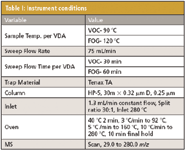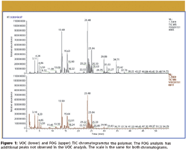Alternate Dynamic Headspace GC–MS Method for Automotive Materials Instead of VDA-278 Thermal Desorption
Synthetic and natural materials are used in motor vehicles to provide appealing and safe vehicle interiors. The manufacturing process for these materials include volatile (VOC) and semi volatile organic compounds (SVOC), which are released into the interior of vehicles. These compounds produce that new smell, but also create fog on interior glass surfaces of the car and can cause health issues.
Synthetic and natural materials are used in motor vehicles to provide appealing and safe vehicle interiors. The manufacturing process for these materials include volatile (VOC) and semi volatile organic compounds (SVOC), which are released into the interior of vehicles. These compounds produce that new smell, but also create fog on interior glass surfaces of the car and can cause health issues.
VDA 278 is currently used by vehicle manufacturers and their suppliers to test manufactured materials for VOC-SVOC emissions and fogging compounds. VDA-278 uses thermal desorption (TD) to analyze the sample. The disadvantage of TD is the sample must fit into a tube with a 4 mm ID. Mechanical reduction of samples can drive off VOCs creating false negative results.

Table I: Instrument conditions
A dynamic headspace method was investigated to provide an alternate method for thermal desorption which minimizes sample size reduction.
Instrument Parameters
Teledyne Tekmar's HT3™ Headspace and a Thermo DSQII GC–MS were used. The conditions are listed below. VDA 278 has separate GC–MS conditions for VOC and FOG analysis. The headspace method followed the sampling requirements of VDA 278, but only the VOC GC–MS temperature profile was used so the difference between VOC and FOG headspace parameters could be shown.
Sample Preparation
Two automotive polymer rods, 3 × 10 mm, were placed into a headspace vial without cutting the sample.
The vial was analyzed by the VOC GC–MS headspace method. The vial was then re-analyzed by the FOG headspace method, but with the VOC GC–MS conditions. The VOC GC–MS method was used for the FOG sample for better data comparison.
Data
The Total Ion Current (TIC) chromatograms of the VOC headspace method and the FOG headspace analysis are compared in Figure 1.

Figure 1
Conclusion
The dynamic headspace method indicated a difference in the same sample similar to the VDA-278 method.
The Tekmar HT3™ Headspace with the dynamic option provides an alternative method for VDA 278, from a single sample. The HT3™ decreases the amount of sample handling reducing the potential of a false negative for these samples.

Teledyne Tekmar
736 Socialville Foster Road, Mason, OH 45040
tel. (800)874-2004; fax (513)229-7050
Website: www.teledynetekmar.com

SEC-MALS of Antibody Therapeutics—A Robust Method for In-Depth Sample Characterization
June 1st 2022Monoclonal antibodies (mAbs) are effective therapeutics for cancers, auto-immune diseases, viral infections, and other diseases. Recent developments in antibody therapeutics aim to add more specific binding regions (bi- and multi-specificity) to increase their effectiveness and/or to downsize the molecule to the specific binding regions (for example, scFv or Fab fragment) to achieve better penetration of the tissue. As the molecule gets more complex, the possible high and low molecular weight (H/LMW) impurities become more complex, too. In order to accurately analyze the various species, more advanced detection than ultraviolet (UV) is required to characterize a mAb sample.














